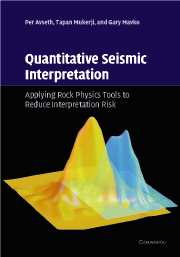Book contents
- Frontmatter
- Contents
- Preface
- 1 Introduction to rock physics
- 2 Rock physics interpretation of texture, lithology and compaction
- 3 Statistical rock physics: Combining rock physics, information theory, and statistics to reduce uncertainty
- 4 Common techniques for quantitative seismic interpretation
- 5 Case studies: Lithology and pore-fluid prediction from seismic data
- 6 Workflows and guidelines
- 7 Hands-on
- References
- Index
- Plate section
6 - Workflows and guidelines
Published online by Cambridge University Press: 27 January 2010
- Frontmatter
- Contents
- Preface
- 1 Introduction to rock physics
- 2 Rock physics interpretation of texture, lithology and compaction
- 3 Statistical rock physics: Combining rock physics, information theory, and statistics to reduce uncertainty
- 4 Common techniques for quantitative seismic interpretation
- 5 Case studies: Lithology and pore-fluid prediction from seismic data
- 6 Workflows and guidelines
- 7 Hands-on
- References
- Index
- Plate section
Summary
Damn the torpedoes, full speed ahead!
Admiral David Glasgow FarragutIn this chapter we provide a summarizing workflow, or road map, explaining the major steps of the methodologies for seismic reservoir prediction and characterization presented in this book. In the description of the workflows we consider the term AVO to represent all offset reflectivity-dependent seismic attributes. These are not limited to the classical intercept–gradient attributes but also include other elastic parameters extracted from pre-stack data such as near- and far-offset impedances, elastic Lamé parameters, converted wave impedance, P-wave and S-wave impedances, and density. The workflows are general and are applicable to any quantitative seismic attribute that can be linked to rock properties.
A complete workflow of quantitative seismic interpretation should also include some necessary qualitative steps, including AVO reconnaissance, semi-quantitative feasibility studies based on well-log analysis, and qualitative interpretations of the inversion results. Below, we list our recommended techniques to be included in a combined qualitative and quantitative seismic interpretation workflow:
AVO reconnaissance and seismic anomaly hunting (performed together with conventional seismic interpretation, not afterwards!).
Well-log-based rock physics and AVO feasibility study (rock physics templates (RPTs) and cross-plot analysis, lithology and fluid substitution, forward seismic modeling).
RPT interpretation of elastic inversion results.
AVO lithology and fluid classification constrained by rock physics depth trends.
AVO analysis and classification constrained by statistical rock physics and facies analysis of well logs.
Elastic inversions and classification constrained by statistical rock physics and facies analysis of well logs.
Quantifying the uncertainty associated in the interpretations in terms of prob-abilities.
All the methodologies listed above are complementary to each other, yet they should be applied at different stages during exploration and production of an oil field.
Information
- Type
- Chapter
- Information
- Quantitative Seismic InterpretationApplying Rock Physics Tools to Reduce Interpretation Risk, pp. 317 - 331Publisher: Cambridge University PressPrint publication year: 2005
